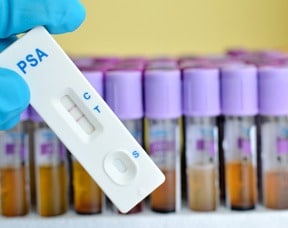A new study from the University Health Network (Toronto) evaluated the impact of the guidelines against Prostate Specific Antigen screening on cancer detection rates and found that intermediate to high grade prostate cancers (defined as Gleason scores 7-10) detected per month had decreased from 17 to 10.
“This is not a subtle decrease and a big cause for concern,” said Dr. David Samadi, Chairman of Urology and Chief of Robotic Surgery at Lenox Hill Hospital. “That much of a decrease in aggressive prostate cancer detection could mean that younger men are out there right now with high-risk prostate cancers, and with these guidelines, will go undiagnosed. Men are deviated away from this important screening and miss the optimal cancer detection period for the most successful treatment and outcome. A simple PSA blood test can indicate current antigens in the prostate. It’s quick and painless. I’ve seen it over and over again in my practice. This screening truly saves lives.”
Researchers analyzed a total of 3,408 prostate biopsies and 1601 prostate cancers were detected. The U.S. Task Force Guidelines were based on evidence that low risk prostate cancer is over diagnosed and over treated. In this study, low risk prostate cancers detected per month did decrease from 8.5 to 5.5.
In spite of the guidelines, Dr. Samadi recommends all men get a baseline PSA at the age of 40 and to know their risk factors.
Instead of focusing on the benefits of PSA screening and how much it has actually helped the healthcare system, their recommendations focus on the complications of treatment, such as incontinence and erectile dysfunction.
However, these complications depend on how experienced the surgeon is that you are being treated by. Prostate cancer mortality was on the decline before the USPSTF issued its recommendation. Since incorporating the PSA test, there has been a 40 percent reduction in prostate cancer mortality in the United States.
“The PSA test is not a prostate cancer test, but it is a vital first step in identifying the potential presence of the disease. I am a firm believer in routine PSA screenings. In my experience, an elevated PSA is how many of my patients were diagnosed, combined with knowing their risk factors like family history. In the end, when we look back, that test saved their lives,” stressed Dr. Samadi.
At Dr. Samadi’s Prostate Cancer Center, the key approach is measuring the trend and velocity of the PSA over time. PSA mapping by a prostate cancer expert is the best way to determine if elevations are a cause for concern. A PSA level of 4.0 ng/mL is normal, while changes of more than 2.0 ng/mL over the course of a year could be an indicator of the presence of Prostate Cancer. But an elevated PSA must be weighed against specific Prostate Cancer risk factors such as age, family history and lifestyle habits.
Did the U.S. Task Force make the wrong call when it comes to screening for prostate cancer? The evidence is arising but you decide.
Men newly diagnosed with prostate cancer can contact world renowned robotic prostate surgeon, Dr. David Samadi, for a consultation via ProstateCancer911.com and by calling 212-365-5000.


